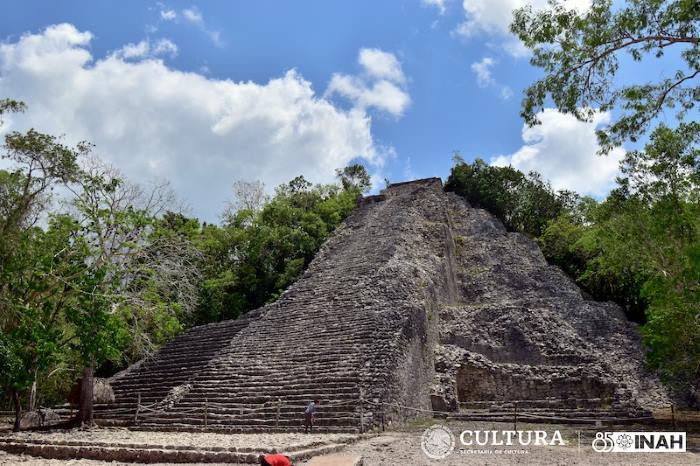Tulum, MX — The federal Secretary of Culture, through the National Institute of Anthropology and History (INAH), has taken measures to preserve the monument dubbed the "Foundation Rock," which is approximately 1,500 years old and was discovered by archaeologist Ana Calderón in the Cobá Archaeological Zone in Tulum. Today, the INAH reveals that the Foundation Rock, one of the most extensive stelae discovered in this archaeological zone, continues to yield the secrets of its inscription. The most recent finding from its hieroglyphic analysis points to the identification of one of its rulers, Ix Ch’ak Ch’een, who led the city of "agua picada" in the 6th century AD.
Although the rock, located at the edge of the aguada, or natural reservoir, of the Nohoch Mul Group, contains some eroded passages and adhered concretions, conservation tasks coordinated by restorer Eunice Corazón Peralta have allowed epigraphers David Stuart from the University of Texas at Austin, and Octavio Esparza Olguín from the National Autonomous University of Mexico (UNAM), to advance in its interpretation.
For example, it is possible to identify the date 9.6.15.6.9 (corresponding to May 12, 569 AD), linked with the foundation or beginning of the institution of the kaloomte’, in a place called Kehwitznal or "place of the deer mountain," a name that must be associated with the Nohoch Mul Group, where the structures with the largest construction volume in Cobá were erected.
The person associated with this event is a ruler, whose name on the Foundation Rock is preliminarily read as Ix Ch’ak Ch’een. This ruler also appears referenced on Panel 7 and on Stelae 26 and 30 of Cobá, associated with the construction of the ball court of Group D or a new architectural phase, and the completion of the seventh k’atun in 9.7.0.0.0 (December 8, 573 AD).
"In these monuments the variants of the name are slightly different, as in the case of Stela 30 where she is mentioned as Ix Ch’ak Ch’een Yopaat, while in the text by the aguada she is associated with the term K’awiil; however, the closeness of the dates indicates it is the same sovereign," indicates the specialist.
On the Foundation Rock, he continues, the enthronement of the ruler is also referenced, although the date is not clear, as is her relationship with the protective deities of the site, such as Bolon Tz’akab Ajaw or "Lord of Innumerable Generations," which within the narrative are linked with the formation or creation of Cobá, in which the ruling lineage also seems to be mentioned.
According to Esparza Olguín, besides the information about Ix Ch’ak Ch’een, the text addresses passages related to the witz’ serpent, an entity associated with bodies of water, which had an intimate relationship with the aguada of the Nohoch Mul Group—a transcendental element within the landscape for the Cobá dynasty—and in whose immediate vicinity the hieroglyphic text was carved directly onto the stone slab.
The epigraphic study considers contrasting the findings with inscriptions from other Maya sites. In this sense, by comparing data contained in texts from Okop (also named Yo’okop, in the municipality of José María Morelos) with mentions on the Foundation Rock, it is inferred that there was a link between the sovereign Ix Ch’ak Ch’een and Testigo Cielo, a powerful ruler of the Kaanul political entity, "although we do not know the nature of this relationship due to a lack of clear references of that dynasty in Cobá."
Discover more from Riviera Maya News & Events
Subscribe to get the latest posts sent to your email.
